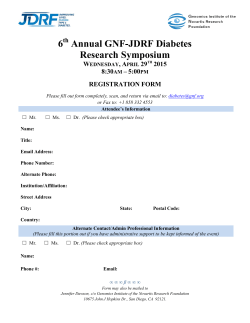
Glicron CR Capsule
Glicron® CR Gliclazide BP PRESENTATION Glicron® CR: Each controlled release capsule contains 30mg Gliclazide. INDICATION This medication is recommended in adults for non-insulindependent diabetes (type II), in association with dietary measures and with physical exercise, when these measures alone are not sufficient to obtain normal blood glucose levels. MODE OF ACTION Glicron® CR: (gliclazide) is a second generation hypoglycemic sulfonylurea. Gliclazide stimulates insulin secretion by the beta cells of pancreas. In addition, its extra pancreatic effects improves metabolic utilization of glucose at a peripheral level. In man, apart from having a similar hypoglycemic effect to the other sulfonylureas, gliclazide has been shown to reduce platelet adhesiveness and aggregation and increase fibrinolytic activity. These factors are thought to be implicated in the pathogenesis of long-term complications of diabetes mellitus. DOSAGE AND ADMINISTRATION Initial dose is 1 capsule (30mg) once daily. If necessary, the daily dose can be increased in 30mg increments up to 120mg once daily. An interval of 2 to 4 weeks between dose increases is recommended. CONTRAINDICATIONS Gliclazide should not be used in: Juvenile onset of diabetes. Diabetes complicated by ketosis and acidosis. Pregnancy, Diabetes undergoing surgery, after severe trauma or during infections. Patients known to have hypersensitivity to other sulfonylureas and related drugs. Diabetes pre-coma and coma. Severe renal and hepatic insufficiency. WARNINGS AND PRECAUTIONS Care should be exercised in patients with hepatic and/or renal impairment and a small starting dose should be used with careful patient monitoring. As with our other sulfonylureas, hypoglycemia will occur if the patients’ dietary intake is reduced or if they are receiving a larger dose of gliclazide than required. DRUG INTERACTION Care should be taken when giving gliclazide with drugs, which are known to alter the diabetic state or potentiate the drug’s action. The hypoglycemic effect of gliclazide may be potentiated by phenylbutazone, salicylates, sulphonamides, coumarin derivatives, MAOIs, beta-adrenergic blocking agents, tetracycline compounds, chloramphenicol, clofibrate, disopyramide, miconazole (oral forms) and cimetidine. Corticosteroids, oral contraceptives, thiazide diuretics, phenothiazine derivatives, thyroid hormones and abuse of laxatives may diminish it. USE IN PREGNANCY AND LACTATION Pregnancy: Gliclazide should not be used in pregnancy. Nursing mothers: It has not been established whether gliclazide is secreted in human milk. However, other sulfonylureas have been found in breast milk and there is evidence to suggest that gliclazide differs from the group in this respect. ADVERSE REACTION All sulfonylureas are capable of producing moderate to severe hypoglycemia particularly in the conditions when patients are controlled by diet alone; in case of accidental overdose; when calorie or glucose intake is deficient; in patient with hepatic and/or renal impairment. Mild GI disturbance including nausea, dyspepsia, diarrhea and constipation have been reported, but this type of adverse reaction can be avoided if gliclazide is taken during a meal. Skin reactions including rash, pruritis, erythema, bullous eruption; blood dyscrasia including anaema, leucopenia, thrombocytopenia and granulocytopenia have been observed during treatment with gliclazide but are not known to be directly attributable to the drug. OVERDOSE The symptoms to be expected with an overdose would be hypoglycemia. The treatment is gastric lavage and correction of the hypoglycemia by appropriate means with continued monitoring of the patient’s blood sugar until the effect of the drug has ceased. PHARMACEUTICAL PRECAUTION Store in a cool and dry place. Keep away from light and children. PACKAGE QUANTITIES Blister pack containing 3x10 capsules. ® Trade Mark Mirpur, Dhaka, Bangladesh
© Copyright 2025









